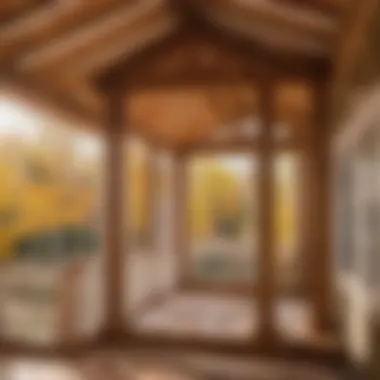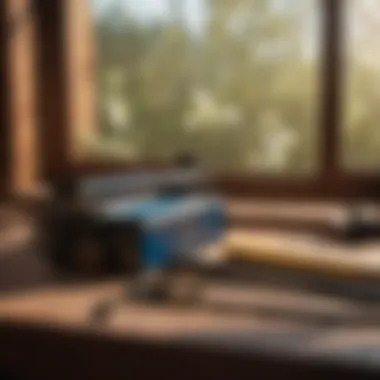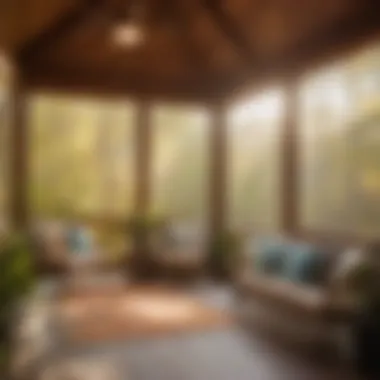Materials:
To begin screening in your porch, it is essential to gather all the necessary materials. Ensure you have the following items in precise quantities:
- Screening Material: Select high-quality screening material such as fiberglass or aluminum, measuring the dimensions of your porch for accurate coverage.
- Screening Frame: Purchase a durable screening frame that fits the measurements of your porch. Options include aluminum or wooden frames.
- Screening Spline: Acquire enough screening spline to secure the screening material into the frame effectively.
- Screening Tools: Gather essential tools like a utility knife, measuring tape, staple gun, and scissors for precise installation.
- Fasteners: Choose suitable fasteners such as screws or nails to secure the frame to the porch structure.
- Screen Door Kit: If adding a screen door, obtain a screen door kit with all necessary components.
DIY Steps:
Once you have all the materials ready, follow these detailed instructions to successfully screen in your porch:
- Measure and Cut Frame: Begin by measuring your porch dimensions accurately and cutting the frame to fit securely.
- Attach Frame: Using appropriate fasteners, attach the frame to the porch structure, ensuring it is level and secure.
- Install Screening Material: Stretch the screening material across the frame and secure it in place with the screening spline, starting from one corner and working your way around.
- Secure Screen Door: If adding a screen door, assemble the screen door kit as per the instructions and install it into the framed opening.
- Trim Excess Material: Trim any excess screening material and spline for a neat and professional finish.
Technical Aspects:
In addition to the materials and steps, focus on these technical aspects to enhance the quality of your DIY porch screening project:
- Timing: Plan your project based on weather conditions to ensure optimal installation outcomes.
- Tools: Utilize the right tools for accurate measurements and precise cuts, enhancing the overall result.
- Techniques: Employ proper techniques when stretching and securing the screening material to avoid wrinkles or creases.
- Safety: Prioritize safety measures during the installation process to prevent accidents or mishaps.
DIY Project Process:


Following the sequential steps detailed above, ensure a systematic installation method that incorporates key techniques and timings for a seamless porch screening experience. Throughout the project, be prepared with troubleshooting tips to address common mistakes or adjustments that might arise, ensuring a successful and aesthetically pleasing outcome. Remain diligent and attentive to detail, as each step contributes to the overall effectiveness and durability of your screened-in porch.
Introduction


The topic of porch screening holds significant importance in this comprehensive guide as it delves into the crucial aspect of transforming a standard porch into a versatile and comfortable living space. Porch screening offers homeowners a myriad of benefits that go beyond just aesthetics. By enclosing a porch, individuals have the opportunity to create an outdoor sanctuary that protects them from insects, weather elements, and provides a sense of seclusion and privacy. Furthermore, a screened-in porch can increase the overall value of a property, making it a wise investment for homeowners looking to enhance both their living space and the resale value of their home.
When embarking on the journey of screening in a porch, there are essential considerations that individuals need to account for in order to execute the project successfully. Factors such as the purpose of the screened porch, budget constraints, and desired functionality all play a critical role in determining the type of screening system and materials to be used. Understanding these considerations beforehand is paramount in ensuring that the screening project aligns with the homeowner's vision and requirements.
This guide aims to equip individuals with the knowledge and insights necessary to navigate the process of porch screening effectively. By providing detailed information on the benefits, types of screening materials available, and key considerations to ponder before commencing the project, readers will gain a holistic understanding of the topic and feel confident in their ability to tackle the screening process with precision and foresight.
Understanding Porch Screening


Porch screening is a crucial aspect of transforming your porch into a functional and inviting space. In this comprehensive guide on how to screen in your porch, understanding porch screening lays the foundation for the entire project. By comprehending the benefits, types of screening materials, and essential considerations, you can make informed decisions and ensure a successful outcome.
Benefits of Porch Screening
Screening in your porch offers a range of benefits that enhance your living experience. Firstly, it creates a barrier against insects and pests, allowing you to enjoy the outdoors without unwelcome visitors. Additionally, porch screening provides protection from debris, dust, and harsh weather conditions, extending the lifespan of your porch furniture and decor. Moreover, screened porches offer increased privacy, shielding you from prying eyes while maintaining airflow and natural light.
Types of Screening Materials
When embarking on a porch screening project, understanding the various screening materials is crucial. Common options include fiberglass, aluminum, vinyl-coated polyester, and solar screening. Each material boasts unique characteristics in terms of durability, visibility, and maintenance requirements. Fiberglass is a popular choice for its affordability and resistance to dents, while aluminum offers strength and rust resistance. Vinyl-coated polyester is known for its insect-repelling properties, and solar screening provides energy-efficient solutions by reducing heat and glare.
Considerations before Screening
Before screening in your porch, several considerations should be taken into account to ensure a seamless process. Begin by assessing your porch's structural integrity and identifying any necessary repairs or reinforcements. Consider the local climate and exposure to sunlight when selecting screening materials to ensure longevity. Additionally, ponder on desired functionalities such as ventilation and visibility to select the most appropriate screening system. Factor in budget constraints, maintenance requirements, and desired aesthetics to make informed decisions for a successful porch screening project.
Preparing for Porch Screening
In the process of screening in a porch, adequate preparation is crucial to ensure a smooth and successful project. Preparing for porch screening involves several key elements that lay the foundation for the rest of the process. One of the essential aspects is understanding the benefits of porch screening, such as creating a comfortable outdoor space free from bugs and debris while adding value to your home. Additionally, considering factors like your porch's size, location, and intended use is vital in determining the right screening materials and system. This phase sets the stage for a well-executed project by taking the time to plan and gather all the necessary tools and materials before diving into the installation process.
Gathering Necessary Tools and Materials
Before embarking on the porch screening project, it is crucial to gather all the necessary tools and materials to ensure a seamless installation process. Some of the basic tools required include a measuring tape, a level, a staple gun, utility knife, and screwdriver. The materials needed typically include screening material such as mesh or wire, framing materials like wood or aluminum, and hardware such as screws and nails. Ensuring you have all the tools and materials on hand before starting will help prevent delays and interruptions, allowing for a more efficient and precise installation.
Measuring and Planning
Measuring and planning are fundamental steps in preparing for porch screening. Accurate measurements of the porch dimensions are essential to determine the amount of screening material and framing needed for the project. Planning involves deciding on the type of screening material that best suits your needs, considering factors like durability, visibility, and maintenance requirements. Additionally, creating a detailed layout and design plan before starting the installation ensures that each step is executed accurately and according to your vision for the screened porch.
Choosing the Right Screening System
Selecting the appropriate screening system is a critical decision in preparing for porch screening. There are various screening systems available, such as traditional screen panels, retractable screens, or even removable screens for seasonal use. Factors to consider when choosing a screening system include the porch's layout, desired functionality, and aesthetic preferences. Understanding the pros and cons of each system can help you make an informed choice that aligns with your specific needs and complements the overall design of your porch.
Installing Porch Screening
Installing porch screening is a crucial step in the process of creating a screened-in porch. This section focuses on the essential aspect of incorporating screening into your porch to create a functional and enjoyable outdoor space. By understanding the importance of proper installation, you can ensure a durable and aesthetically pleasing result.
Setting Up the Frame
Setting up the frame is a foundational step in porch screening installation. The frame provides structural support for the screening material, ensuring a secure and sturdy enclosure. Proper framing helps in creating a seamless look and enhances the overall appearance of the porch. It is essential to select durable and weather-resistant materials for the frame to withstand varying weather conditions.
Attaching the Screening Material
Attaching the screening material is a critical task in the porch screening process. Careful attention must be paid to ensure that the material is evenly stretched and securely attached to the frame. Proper attachment is essential to prevent sagging or tearing of the screen over time. It is advisable to use high-quality screening material that is designed for durability and optimal visibility.
Securing the Screen
Securing the screen is the final step in porch screening installation. This involves ensuring that the screen is tightly fastened to the frame to prevent any movement or loosening. Properly securing the screen helps in maintaining its integrity and prolongs its lifespan. It is important to inspect the screen periodically and make any necessary adjustments to maintain its tautness and functionality.
Adding Finishing Touches
In the final stage of screening in your porch, adding finishing touches plays a crucial role in enhancing the overall look and functionality of your space. From trimming and reinforcing to painting or staining and even installing accessories, these final touches can truly elevate the quality of your screened porch.
Trimming and Reinforcing
Trimming and reinforcing the screened porch not only adds a polished finish but also provides additional strength and durability to the structure. Trim work around the edges creates a seamless transition between the screens and the frame, giving a clean and professional look. Reinforcing key areas where the screening material meets the frame ensures the longevity of your porch screening.
Painting or Staining
Painting or staining the frame and trim of your porch screening not only adds aesthetic appeal but also acts as a protective barrier against the elements. Choose a color that complements your existing décor or exterior of your home. Stain offers a natural look while paint allows for more customization. Ensure the products used are suitable for outdoor use to prevent premature wear and tear.
Installing Accessories
The final step in finishing your screened porch involves installing accessories that enhance its functionality and style. Consider adding lighting fixtures for evening use, decorative hooks for hanging plants or outdoor décor, or even a ceiling fan for added comfort. Accessories help personalize your porch and create a welcoming outdoor retreat that can be enjoyed year-round.
Maintenance and Care
Maintaining and caring for your screened-in porch is essential to ensuring its longevity and functionality. In this section, we will delve into the importance of proper maintenance and care, highlighting specific elements that will help you preserve your porch screening investment.
Regular maintenance is crucial in upholding the structural integrity of your porch screening. By regularly inspecting for tears, holes, or loose edges in the screening material, you can promptly address any issues before they worsen. Additionally, maintaining the cleanliness of your porch screening can help prevent buildup of dirt, debris, and pests, ensuring a pleasant and comfortable outdoor space.
Caring for your porch screening also involves seasonal considerations. During harsh weather conditions, such as heavy rain or storms, it is advisable to check for any damage and make necessary repairs promptly. Applying protective coatings or sealants can also extend the lifespan of your screening material.
In essence, effective maintenance and care of your screened-in porch not only enhances its aesthetic appeal but also safeguards your investment in the long run, providing you with a functional and enjoyable outdoor space.
Cleaning Tips
Keeping your porch screening clean is imperative for maintaining its appearance and functionality. Regular cleaning not only improves the visual appeal of your porch but also helps prevent the accumulation of dirt and grime that can deteriorate the screening material over time.
Begin by removing debris such as leaves, twigs, and dust from the surface of the screening material using a soft brush or vacuum cleaner. For tougher stains, gently scrubbing with a mild detergent solution and rinsing with water can help restore the cleanliness of the screening.
It is important to avoid using harsh chemicals or abrasive cleaning tools that can damage the screening material. Instead, opt for gentle cleaning methods to ensure longevity and optimal performance of your porch screening.
Repairing Damages
Addressing damages to your porch screening promptly can prevent further deterioration and prolong its lifespan. Whether it's a small tear, hole, or loose edge, timely repairs can prevent pests from entering and maintain the integrity of the screening.
To repair small tears or holes, using a patch kit specifically designed for your screening material can effectively seal the damaged area. For more extensive damage, replacing sections of the screening may be necessary to ensure proper functionality and visual appeal.
Regular monitoring and quick action in repairing damages will not only maintain the aesthetics of your porch but also ensure a comfortable and secure outdoor space for years to come.
Seasonal Maintenance
Seasonal maintenance is vital for preparing your screened-in porch for changing weather conditions and ensuring its durability throughout the year. As seasons shift, it is essential to conduct thorough inspections of the screening material and frame to identify any wear, tear, or damage.
During the transition to colder seasons, weatherproofing your porch screening can help insulate the space and protect it from moisture and cold drafts. Applying weather-resistant sealants and checking for gaps in the screening material can enhance the efficiency and comfort of your screened-in porch.
By proactively addressing seasonal maintenance tasks, you can safeguard your porch screening investment and enjoy a well-maintained outdoor retreat no matter the season.





